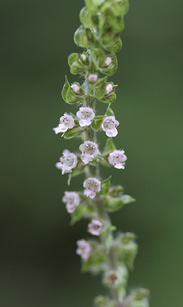Perilla Mint (Perilla frutescens)
Perilla mint is an erect, herbaceous annual weed originally from eastern Asia. Also known as beefsteak plant, common mint, or Chinese basil, this plant has a history of use in the culinary, medicinal, and ornamental markets. In Mississippi, perilla mint has escaped cultivation and frequently occurs in natural areas, including pastures. When populations occur on grazing lands or fields harvested for hay, perilla mint poses serious health risks to livestock. It is considered a noxious weed throughout much of the eastern United States.
Description
Vegetative Growth
A member of the Lamiaceae, or mint, family, perilla mint usually reaches an average height of 2 feet at maturity. However, plants may reach up to 5–6 feet, especially in shaded, fertile areas. Leaves are coarsely serrated and are opposite each other on a square stem (Figure 1). Upper leaf margins and undersides of leaves are frequently purple (Figure 2). Like other plants in the mint family, leaves are highly aromatic when crushed. In Mississippi, seedlings may be seen as early as mid-May or when soil temperatures are between 68 and 77°F.


Flowering
A self-pollinating species, perilla mint typically begins flowering in late July to August, producing flower spikes up to 6 inches long (Figure 3). Each spike contains many small, white to purple flowers. Plants are prolific seeders, having the potential to produce 1,000–1,500 seeds per plant. Seed viability often remains high, with germination studies indicating greater than 60 percent after more than 4 years of room-temperature storage.



Dispersal
Seed is spread by disturbance, birds, or surface water movement. Late-season hay harvests tend to retain mature seed, which are likely transported across farms. Seed readily germinates in highly disturbed conditions. Length of seed viability under normal field conditions is unknown.
Habitat
Perilla mint is highly adaptable, but populations are most often dense and found in semi-shaded wooded understories, along streamside areas, and in damp swales (Figure 4). Disturbed areas of fertile soil around hay rings (Figure 5), feedlots, and barns tend to encourage healthy populations. In pastures, the invasive perilla competes with beneficial forage species, especially during intervals of limited rainfall.


Threat
Several volatile compounds, like perilla ketones, exist in perilla mint and cause atypical interstitial pneumonia (AIP) in cattle and other domestic animals. Fluid accumulates in the lungs, resulting in lower oxygen levels and shortness of breath. Plants are more toxic during flowering and fruiting, which coincides with periods of lower forage quantity and quality, excessive temperatures, and stress caused by insects. As a result, livestock congregate in shaded areas that may be infested with perilla mint (Figure 6). This means exposed livestock are at a greater risk of plant consumption when its toxicity is greatest.

Control Methods
Several herbicides are highly effective for controlling perilla mint. Some preemergence options include picloram, aminopyralid, dicamba, and imazapic (Table 1). These treatments should be applied before seedling emergence and just before rain to incorporate the chemical into the soil. Postemergence options include picloram, 2,4-D, glyphosate, and dicamba (Table 2). These may be applied to emerged plants from seedling through the early flowering stage for effective control. If treating large populations, livestock should be removed from the treated area to reduce risk of ingestion, especially if desirable forage is limited.
Additional control methods include mowing or hand pulling. These physical control techniques are suggested before flowering in late summer to avoid seed production and new plants in the following years.
|
Herbicide |
Trade Name |
Rate (amount product/A) |
|
picloram + 2,4-D |
Grazon P+D |
32 fl oz |
|
aminopyralid + 2,4-D |
GrazonNext HL |
19 fl oz |
|
dicamba + 2,4-D |
Weedmaster |
32 fl oz |
|
imazapic |
Plateau |
6 fl oz |
|
Herbicide |
Trade Name |
Rate (amount product/A) |
|
picloram + 2,4-D |
Grazon P+D |
16 fl oz |
|
aminopyralid + 2,4-D |
GrazonNext HL |
19 fl oz |
|
glyphosate |
RoundUp (41% a.i.) |
24 fl oz |
|
dicamba + 2,4-D |
Weedmaster |
16 fl oz |
|
2,4-D |
2,4-D Amine 4 |
32 fl oz |
All treatments include 0.25 percent v/v non-ionic surfactant.
The information given here is for educational purposes only. References to commercial products, trade names, or suppliers are made with the understanding that no endorsement is implied and that no discrimination against other products or suppliers is intended.
Publication 3865 (POD-10-24)
By John Byrd, PhD, Extension/Research Professor, and David Russell, PhD, former Extension Associate, Plant and Soil Sciences.
The Mississippi State University Extension Service is working to ensure all web content is accessible to all users. If you need assistance accessing any of our content, please email the webteam or call 662-325-2262.


